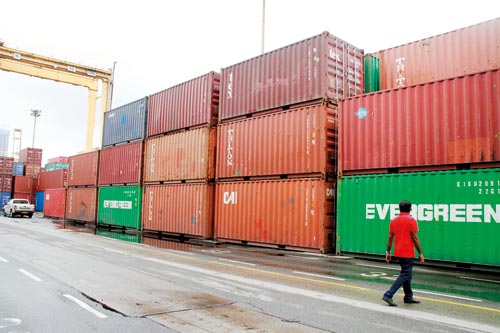“Big global default” and Sri Lanka’s recovery
View(s):
File picture of the Colombo Port. Unlike Sri Lanka, some Asian countries recorded robust export growth despite the COVID-19 crisis
Some time ago a friend of mine was worried about his child who had been attracted to a new group of friends in the school.
At the same time, the father has noticed that the child had distanced himself somewhat from some of his good old friends. As the child had not done well at his O/L examination, the father didn’t want to be rude to him about the change in the child’s circle of friends.
When the child was asked indirectly, it was strange that he talked good things about his new friends, while being not so appreciative about the old friends. However, later the father could solve his puzzle about the child’s behavioural changes.
He realized that all the new friends of his child were also “failures” at the O/L exam one way or the other and that the friends that he distanced got through the exam. Having not done the exam well enough, the child seems to be comfortable with others who are in the same boat.
When he failed mathematics, he was comfortable with others who also failed mathematics! The inverse is also true: He was not so much comfortable with his old friends who had passed the exam including mathematics – some with even credit passes and distinctions. Birds of the same feather flock together!
Old parallels and new parallels
According to a recent UN report named “A world of debt: A growing burden to global prosperity” a total of 52 countries, that is almost 40 per cent of the developing world, are in serious debt trouble. Global public debt has reached an all-time high of US$ 92 trillion in 2022 – a five-fold increase from $17 trillion in 2000.
 During the past 12 years (2010-2021), public debt in developing countries has increased more rapidly than that of developed countries, exposing their vulnerability to a global debt crisis. Developing countries’ total public debt was 35 per cent of GDP in 2010, which has skyrocketed to 60 per cent in 2021. While their external public debt has also increased rapidly, foreign debt obligations as a share of exports have almost doubled, increasing from 3.8 per cent to 7.4 per cent of exports.
During the past 12 years (2010-2021), public debt in developing countries has increased more rapidly than that of developed countries, exposing their vulnerability to a global debt crisis. Developing countries’ total public debt was 35 per cent of GDP in 2010, which has skyrocketed to 60 per cent in 2021. While their external public debt has also increased rapidly, foreign debt obligations as a share of exports have almost doubled, increasing from 3.8 per cent to 7.4 per cent of exports.
While many developing countries are facing an unprecedented danger of being caught up in the global debt trap, Sri Lanka as a crisis-ridden country among them is not alone at all. It is among the countries which have already faced the crisis, such as Zambia, Lebanon, Ghana, Pakistan, Egypt, Tunisia, Malawi, and El Salvador. As information from around the world shows, there are many more countries on the verge of collapsing in the global debt crisis.
Sri Lanka, which once boasted about its human development achievements in terms of education, health, and other social and demographic elements as well as democratic standards, now draws so many parallels with many African and Latin American countries which are down with economic and debt crises.
Moreover, Sri Lanka has gradually lost most of its parallels that were drawn from among its neighbours from East Asia and Southeast Asia as well as now from South Asia. There is almost nothing that Sri Lanka could compare itself with most of the countries in its neighbourhood.
Much in common
Most of the economic characteristics that Sri Lanka has exhibited prior to its debt crisis are common features of debt-ridden developing countries as well as those countries which are on the verge of similar troubles. They have borrowed heavily over the years from both domestic and foreign sources resulting in an increase in their debt-to-GDP ratios reaching 100 per cent.
Apparently, a couple of advanced countries, including the US and Japan have also exhibited high debt-to-GDP ratios. But the difference is that their debt is in their own currency which has acquired an international value, whereas the debt-ridden developing countries have failed to maintain a strong currency through international trade performance.
Accordingly, when they issue their own currency excessively above and beyond their economic growth raising their domestic debt levels, the currency became weaker and weaker. In the absence of substantial export growth leading to weaker currencies, they continued to face ever-increasing pressure on paying their foreign debt as well.
The problem got worse when they turned to “private international creditors”, such as commercial banks, private investment funds, and other lenders, who offer financing on commercial terms. It was easier to borrow from them by issuing international sovereign bonds (ISBs), offering higher risk premium well above the international standards.
Expensive borrowings
Unlike the advanced countries which have the ability to borrow from private creditors at lower cost, developing countries usually pay higher interest rates with a risk premium which made commercial borrowing easier but more expensive for them. According to international data sources, in the past 10 years, the portion of external public debt owed to private creditors has risen across all regions, accounting for 62 per cent of developing countries’ total external public debt in 2021.
When developing countries borrow internationally, not only was their debt more expensive than that of advanced countries, but also, they became increasingly vulnerable to their exchange rate risks and depreciation. High borrowing costs make it difficult for developing countries to fund important investments which in turn further undermines debt sustainability and progress towards sustainable development.
Most of the debt-ridden developing countries have smaller amounts of foreign reserves as small as 10 – 25 per cent of their external debt, their external debt shares run in the range of 100 – 400 per cent of their exports. Excessive borrowings have led these countries to face an ever-increasing budget deficit, partly because they have to allocate higher portion of their tax revenue to pay high interest costs.
With these developments, they have developed a two-sided and inter-related debt problem prior to their fall: The first is the budget deficit, which requires them to borrow more either through domestic or foreign sources in order to cover it. The second is the trade deficit, which is required to cover with foreign borrowings.
Distancing from old friends
Most of the countries in Asia managed to sail in trouble waters without falling into a debt crisis during 2020-2022, because their policy focus was on a reverse course of actions that is international trade performance. Accordingly, they also have demonstrated common characteristics in their policy and economic performance, which enabled them all to pass through the global health and economic crisis successfully.
It was the export growth. Having faced with the COVID-19 pandemic, in general the world experienced a decline in trade volume, breakdown in supply chains, volatile commodity prices and exchange rates. But nevertheless, there is a group of Asian economies which has achieved enough economic immunity through higher export performance in order to face such global disruptions.
Compared with 1.9 per cent annual growth of global merchandise export volume, on average the Asian export growth remained robust at 3.4 per cent during 2010-2020. Leading export performers from Asia included China, Hong Kong, South Korea, Singapore, Vietnam, India, Thailand, Malaysia, and Indonesia. Even the poorer countries like Bangladesh, Cambodia and Myanmar have maintained improved export performance during the past decade.
Stability with growth
Focus on trade performance rather than government spending helped these countries to strengthen the external value of the currency and to build up a stock of external reserves. All the best trade performers had foreign exchange reserves over $100 billion with China and India as good examples. During the crisis time from 2020-2022, they have further improved their stocks of foreign reserves. Even the countries like Bangladesh, Cambodia and Myanmar had built up their stocks of foreign reserves to healthy levels.
With improved trade performance, most of the Asian countries were able not only to maintain healthy external finance positions, but also to achieve sound budgetary positions. Trade performance is the key to maintain economic stability, including their improved “credit- worthiness”.
The ultimate lesson that they teach Sri Lanka is important for the country’s recovery and growth: Improved debt sustainability and credit- worthiness that the country is trying to achieve with reforms should be maintained with better trade performance.
(The writer is a former Professor of Economics at the University of Colombo and can be
reached at sirimal@econ.cmb.ac.lk and follow on Twitter @SirimalAshoka).
Hitad.lk has you covered with quality used or brand new cars for sale that are budget friendly yet reliable! Now is the time to sell your old ride for something more attractive to today's modern automotive market demands. Browse through our selection of affordable options now on Hitad.lk before deciding on what will work best for you!


